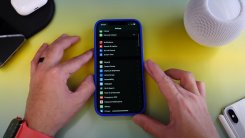Will LinkedIn's Big Redesign Help You Land a Job?
LinkedIn isn’t the most glamorous social network, but the platform’s upcoming redesign could make it a lot easier to use, and potentially more helpful

Would you try a pair of headphones that rests on your cheekbones and sends audio to your ears through your bones? This is possible through a technology called “bone conduction,” and it’s most used in consumer headphones. These products aren’t too expensive and may be a good alternative for people who don’t enjoy using headphones or those who want to try something different. Here’s what to consider before buying a pair yourself.
Normally, when you hear something, you’re hearing it because sound waves have traveled through the air and reached your ear. However, sound can travel through liquids and solids, too—in fact, sound travels fastest through solids. If you were to place your ear on a railway track, you’d hear an oncoming train much sooner than if you simply stood near the tracks (not that we recommend you test this out yourself).
Our bones are solid, too, so they can act as conductors of sound vibrations to our ears. Ever wonder why your voice sounds different to your own ears when you speak, versus when you hear a recording of your voice? That’s because you can hear a part of your own voice being transmitted through your bones—which is, of course, not audible to anyone else.
Bone conduction headphones bypass the outer part of the ear entirely—you’ll usually see them placed on the cheekbones to send audio vibrations through to the inner ear. That means, if you have normal hearing, you will be able to hear environmental sounds clearly while still listening to music, podcasts, or other audio with bone conduction headphones. This is particularly useful in situations in which you need to be aware of other sounds around you, such as when walking or running outdoors. Bone conduction technology is also helpful for some people with hearing impairment—the technology is used in certain types of hearing aids.
Critics of bone conduction point out that these headphones, by design, won’t “seal” your ears the way traditional headphones do, so the sound quality itself won’t be as good. And, because these headphones are placed on your cheekbones, you may find it uncomfortable or impractical to use them during intense physical activity.
These types of headphones, like open-back headphones, also tend to leak sound, so people around you will be able to hear some of what you’re listening to. That will be something to consider if you’re tempted to use them in quiet, contained spaces, such as a library or airplane.
Another challenge you may experience with bone conduction headphones comes from the vibration itself—because these products send sound through your bones, you’ll constantly feel the vibrations in your skull. How annoying those vibrations feel will vary from person to person.
The answer to this question is subjective, depending on your headphone usage, needs, and desire to try out different technologies. For most people, they won’t qualify as a necessity—but they can be beneficial in some situations, including for swimmers who use the waterproof versions, people who have hearing impairment, and those who can’t wear regular headphones due to skin irritation or vertigo issues.
In general, a set of bone conduction headphones, will set you back anywhere from $50 to $200, and some brands, such as Aftershokz, specialize in bone conduction headphones.
If the vibrations aren’t for you, something like the Bose Sport Open earbuds might be an alternative—they offer some of the benefits of bone conduction (they rests lightly on your ear and don’t block your ear canal), minus the vibration.

LinkedIn isn’t the most glamorous social network, but the platform’s upcoming redesign could make it a lot easier to use, and potentially more helpful

While it’s generally good advice for most people to avoid installing a developer beta of iOS on their primary carry devices, that counsel goes out the

Zoom is bringing its Live Transcription feature to free users. Paid users have had access to the service for a while, but free users will soon also ha

A new Google Play Store interface is rolling out now for all Android users. It looks mostly the same as before, but reorganizes the store’s layout and

Google is rolling out its latest Pixel Drop as part of the June 2021 Android security update. For those who don’t know, Pixel Drops are released throu

Though it feels like we’ve been Zooming and FaceTiming and using Google Hangouts for an eternity, most of us have still not figured out how to look go

Big Brother! 1984! Scary buzzwords! Look, it’s understandable why you’d be skeptical of big tech, especially when their products ask for more and more

The iPhone takes very natural-looking photos. It doesn’t do a lot of color correction, it doesn’t saturate colors, and it doesn’t increase the contras
We are a comprehensive and trusted information platform dedicated to delivering high-quality content across a wide range of topics, including society, technology, business, health, culture, and entertainment.
From breaking news to in-depth reports, we adhere to the principles of accuracy and diverse perspectives, helping readers find clarity and reliability in today’s fast-paced information landscape.
Our goal is to be a dependable source of knowledge for every reader—making information not only accessible but truly trustworthy. Looking ahead, we will continue to enhance our content and services, connecting the world and delivering value.